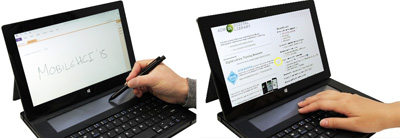DisplayCover
A tablet keyboard with an embedded thin-film touchscreen display
For decades, the Microsoft Applied Sciences Group has been exploring input devices as a means to extend the desktop experience to peripheral hardware and in 2009 the Microsoft Adaptive Keyboard was born. This keyboard featured a large, touch-sensitive display atop a keyboard that continued underneath the keys.

Recently, touch-enabled portable computers have experienced a growing of interest as miniaturization and increases in display resolution enabled manufacturers to produce lighter and more powerful devices with precise multitouch displays. However, there has been little to no research targeting devices whose limited screen size is a concern (e.g. Surface).
DisplayCover is a peripheral cover designed for compact touch-enabled laptops. A tactile keyboard affords users with the comfort and ease of use provided by physical keys. A thinfilm e-ink display with a resolution of 1280 x 305 pixels extends the available screen real estate of the slate device by up to 8% (based on a Microsoft Surface Pro 2 with a 10.6”, 1080p, 208ppi screen). We chose this display due to the bistable nature of electrophoretic ink, reducing the secondary screen’s impact on battery life.

DisplayCover supports dynamic UI manipulation, concurrent access to multiple applications, stylus annotation, gestures and trackpad interactions on the horizontal plane. To illustrate these features, we demonstrated its use in a suite of example applications built around the proposed interaction techniques.

DisplayCover extends the available screen real estate of tablet computers while mitigating occlusion issues associated with direct pen and touch input.

 Applied Sciences
Applied Sciences






